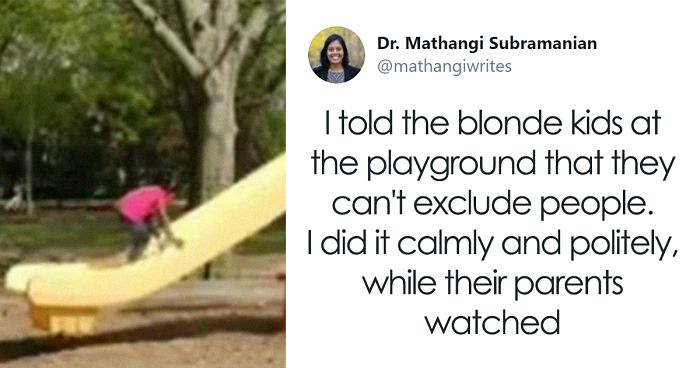
Two Blonde Girls Tell A Girl She Can’t Play With Them, Their Parents Do Nothing So The Girl’s Mom Intervenes
On April 18, 2019, Dr. Mathangi Subramanian turned to Twitter to describe the time her daughter became a victim of playground racism. Sadly, it’s still relevant.
You see, two girls refused to play with Dr. Subramanian’s daughter because her hair wasn’t like theirs. It wasn’t blonde. And the whole situation might’ve gone unnoticed if it wasn’t for Dr. Subramanian. While the parents of the two girls didn’t intervene to teach their children about race, she did.
Using the conflict as an opportunity for growth, Dr. Subramanian took her time to broaden the worldview of all three kids. Naturally, being an award-winning writer and educator, she handled the tough situation perfectly.
More info: mathangisubramanian.com | Twitter
Image credits: mathangiwrites
Image credits: mathangiwrites
Image credits: mathangiwrites
Image credits: mathangiwrites
Image credits: mathangiwrites
Dr. Subramanian said the exact words she told the blonde girls are a bit fuzzy now, but she explained to them that they weren’t allowed to exclude people in a public space like a playground. “I don’t know if they understood the message — I don’t think they did, because they didn’t actually let my daughter play with them,” the mother told Bored Panda.
“[Me and my daughter] have had a lot of conversations about race,” Dr. Subramanian continued. “I told her [on our way home] that sometimes people are mean to each other because of differences and because she and I have dark skin, we might be treated differently. She has faced racism since then, and we’ve revisited this conversation often.”
Here’s what people said after reading the story
Image credits: Raghnaid_Anna
Image credits: jeanniekim
Image credits: LivingInGlitter
Image credits: hiwildflower
Image credits: mathangiwrites
Image credits: WantPeace4All
Image credits: midukee21
Image credits: roisindermody
Image credits: bookwalee
Image credits: eebbonyy
Image credits: LearningLife97
Image credits: MaryEllaJackso1
Image credits: KenTaroPerson
According to Erin N. Winkler, an associate professor at the University of California, Berkeley who specializes in racial socialization, research shows that kids are noticing racialized patterns in the world around them from a very young age and they are trying to figure out those patterns. “Those messages are getting to them from a whole variety of sources, not just from families,” Winkler told EmbraceRace. “They’re getting it from media, books, cartoons and so on and so forth… even if you try to limit your child’s exposure to some of these things, those messages are really getting in from these other sources.”
“We want them to match their shapes and their animals and, you know, match things and learn patterns but they’re trying to figure out the rules from those patterns that they see around them. So families often think that they alone control what children learn. But these messages come from all over,” Winkler said. And that’s why it’s so important to talk to kids about race, to help them navigate these messages.
Dr. Subramanian thinks some white parents don’t initiate these conversations with their children because they’re not faced with it daily. “They don’t think about race because it doesn’t affect them. I don’t talk to my daughter enough about class, for example, because my family is middle class. We all have our blind spots, and it’s important to examine what they are and address them,” she explained.
The mom added that she really appreciates everyone’s support and hopes that now people focus on the words of black mothers and activists and contribute to the Black Lives Matter movement however they can.
All of the positive responses really cheered the mother up
Image credits: mathangiwrites
Image credits: mathangiwrites
When my son was 2,5 (now 7) he saw a person with a different skin color. He asked me why, I was not prepared but I just told him that people can have different color of skin, hair and eyes. He never questioned this again and also gives this explanation to others, including his little brother.
I'm into anthropology it was my major, so I've fielded my son's questions when he was younger by explaining about ancestry, and how that's different to where you were born yourself. He's now 10, and also really wanted to watch a Dr who episode with me, so I chose the only one without a scary alien, which happened to be the Rosa parks episode (he had lots of questions!!). We have had many discussions about how change happens and needs to keep happening, and I've underlined to him that he needs to be aware that as he is white he has an unfair automatic advantage in many ways, and to use it to stand up for others who won't be listened to. (He's an onto it kid, he was late developing mobility wise and made up for it by excelling in language skills. But he's all caught up mobility wise now ^-^)
Load More Replies...Kids exclude other kids all the time for a million random reasons. The blonde girls parents should have intervened because excluding others kids is wrong, period. Calling it racism is a wild stretch.
at this age, one cannot describe this racist attitude on the part of his two little daughters. As my neighbor points out above, children need to distinguish themselves from each other: whether by the color of the t-shirt, hair, skin, their plush, colored pencils, their bandana or other. others I know (Dad's car brand, clothing brand, etc., will be larger). On the other hand, education must make them understand that it is not a good attitude to have.
Load More Replies...We need to keep in mind a few things here, all at the same time, things that people have said in various comments: 1. These are little children being mean to each other. 2. They will be mean to one another about skin colour, hair colour, sweater colour, a handicap, backpack colour, the biscuits brought as a snack, visible religious symbols, the brand of their shoes, and whatever other reason we can think of. 3. Kids will often try to form a group of similar kids, and they don't realise they're being hurtful doing so. As parents, we have to address THAT behaviour. Not just with words, but with deeds of our own as well. If we don't address it, it may develop into racism indeed. 4. It is ALWAYS wrong to exclude other kids (or adults!!) based on "external" factors, if you've never tried to get to know them. I believe that is what parents should teach their children.
I wasn't being sarcastic, MellonCollie. I liked your comment.
Load More Replies...Yeah, I hate when people say "I raise my children to be colorblind" because that means there kids don't know about all the discrimination and stuff, and so they end up being rascists
While I understand your frustration with the phrase, I use it all the time. When I say “My parents raised me colorblind” I mean my parents had these long conversations with me about race and what not, so from a young age I knew that racism was wrong. The phrase to me refers to the fact that I will not judge a person based on their color or what not, but on the person beneath the skin. There is nothing wrong with the phrase, it’s how you use it.
Load More Replies...Children that young won't understand equality until they are taught. My 4yo nephew came back from nursery saying a boy looked scary because he was disabled so my sister talked to him about how everyone looks different but they can still play and be good friends. It's the adult's job to lead by example with children and ensure stereotypes and prejudices are challenged. I worry that white children are losing out opportunities to learn about an inclusive society because adults don't think to talk about it.
When living in Hong Kong, and on a hike one day, we heard the cries of a small child from not far away. A nearby Chinese couple were startled like us, and went to investigate, as did we, not far behind. When they saw it was a little white boy, they said, in Chinese, 'oh it's only a white kid' (and used a pejorative term for that I should add) and walked off!! He was 4 years old and lost on a hike! Of course we intervened and found his family who weren't that far off but far enough away in 4 year old terms. I was disgusted by that couple. But. He was a white boy. So it's OK to discriminate against him I guess. Note: sarcasm. No, it wasn't one off. As a bi lingual person, who could understand what people said, I saw it all the time. This is not an issue unique to 'blonde, white people', but that ain't trendy, so.
No one should be racist against anyone else and that couple was just plain rude.
Load More Replies...You can tell what the kid hear at home from a young age. I was teaching kids (4/5 yo) with learning difficulties at preschool, i was teaching them to learn the alphabet and a girl shout "Abderrazek don't need to learn to read since he's an arab!" OUCH A kid, outraged speaks up for the boy "madam, madam tell her it's bad to say things like that!It's bad am i right madam?" And then i had to teach them a totally different course, walking on eggs. It was genuine from the little girl she meaned no harm but you can tell what she's hearing at home, and how the little boy was raised. It's sad that such small kids have to deal with racism from the beginning of their lives.
When camping in British Columbia, the family camping beside us were black and they had kids. My boys walked right over to them and asked “do you want to play?” No one is born with hate, it is taught.
Prejudice is learned at a very young age. If we're not actively talking about race with our kids, they are going to pick up on all the insidious institutional racism that exists and internalize it.
It's very true. I remember one boy coming to school (fat tuesday is like halloween in France, cosplay) with a blackface cosplay. He wore it the entire day with no problems. When i told that to my mom i had a lesson about why it is wrong, thanks to her because the school did nothing about it.
Load More Replies...Actually no, it shouldn’t be uncomfortable for white parents to talk to their kids about race. It’s very simple to explain that not everyone is blonde and that is a good thing. Have the conversation of race so much with your kids that it becomes a normal part of their lives. The “it’s so hard to talk to your kids about it”, it’s complete BS. I was always hoping that the generation of people having kids now, would be better than their parents when it came to racism. But unfortunately, the ignorance is still being passed on. It’s time that we all accept that the white race is not superior, and never was. If it makes you feel better to think that you are better because of the color of your skin, then your problem is much deeper than racism.
we had a black skinned family living in your neigborhood... Their kinds playing on the playground just absolutely normally.... Im normal white gurl, but i always weight more than normal kids. Sure, my fault but... you know..... Those children from that family of nonwhite family bullied me the most... Sure, almost all children bullied me because of my weight, but those two, sister and brother, even hit me and throw a rock on me.... Well... what I need to say is... Im absolutely against racism, but in the end... it is not about the colour of skin, it is about character of the people!
It figure that you yourself admit you were tainted by all for being fat but you supposedly remember the “black skinned” kids treatment the worst out of all? Hah! Sure Jan! Look at you trying to solicit pity while still displaying your own bias. You forgave all the other little normal white demons that tormented you so let the other shyt go too hah
Load More Replies...While living in Puerto Rico (daughter was 5 yr old) two neighbors were 2 lil dark skinned girls. They wouldn't play w/ ny daughter cause she is fair skinned. One girl's mother was white and the other girl's paternal grandmother was white !!! But they automatically hated my daughter cause she's white skinned. !!! Ain't that some bullshxx .
Well you paint an extreme picture but it's all assumptions. It really sounds like you suffer from low self esteem and have found comfort in being a victim. Did you sit and question the 2 little girls and they told you they "hated" your child and wouldn't play with her because she was "fair skinned" ? I doubt you did. Young children often practice their social interactions based on their mood at the moment. Kids are just that KIDS ! and they are not aware of acceptable social standards at that age. How you can get on here and post "But they automatically hated my daughter cause she's white skinned. !!! Ain't that some bullshxx " is a direct reflection of your own deficiencies comprehending the difference between social etiquette and racism.
Load More Replies...Jumping to the conclusion that a 3 years old child is being racist is harsh and not adult at all. This has been taken to a personal level 35+ years old contra 3 year old? It is okay to educate kids on the fact that people are different, and this is good, this is normal and we should accept each other's diversity, still, a kid has it's own right to choose with who it wants to play. The girls might have just made up a reason (blonde hair thing) to motivate their choice, but honestly, don't adults as well do the same? Do all of you grownups just run around and be friends with everyone? NO, I bet you don't, you have the right to choose in your personal social life with who you get along(and sometimes you just don't have a logical reason,you just don't like someone,period. - that's when you might come up with a white lie,why you avoid them). Conclusion: kids need to learn about acceptance,but adults must show them example. This was a very badly chosen time to 'teach those kids a lesson'.
My son was in a speech impact class at 3. When he came home I asked if he had made any friends. He said he made friends with the black girl. I was a little shocked that he would refer to someone that way, especially since he barely talked, hence the speech class. I said that was nice and looked forward to meeting her at the next class. It was a small class, only 9 kids. I get there, no children of color. I'm stumped. I asked who his friend was. He pointed and said the purple girl. He was talking about clothing. But it was a teachable moment where we talked about people having different skin colors and when he got a new boy in class who was Hispanic, he was the blue boy.
I fear that it is sometimes difficult to distinguish "general" discrimination from racism. This is a helpful reminder for everyone: https://www.amnesty.org/en/what-we-do/discrimination/ We need to see little girls behaving like little pricks for what it is. It happens between white girls too, you know - and I know you know, just think back of your own elementary or secondary school days, folks. In fact, I'm pretty sure it happens between ALL kids from ALL OVER the world - until they are TAUGHT otherwise. It's also very important for the bullied kid to learn how to stand up for themselves.
When I was in kindergarten I was playing with my friend and a little boy told her she shouldn't play with me because I'm white....that was a Christian school btw and we played together anyway, but I remember that was the first time I had ever heard anyone say that people of different races or "colors" as I knew them back then because I was only 5..shouldn't play together and I thought it was really weird anyone would think that.
Okay, let me stop with the assumption that a 3 year old is being taught to be racist. Kids are weird, they come up with weird things and they can be cruel because they don't realize how their actions hurt others. However, they should have been hauled off the playground for excluding someone based on their appearance.
Well you nicely contradicted yourself. Youngsters say and do many things without any understand of their actions. You're saying that's true about race but then you say they should face punishment when the same action is about "appearance" . Easy to see why kids grow up confused.
Load More Replies...Not seeing the racism here. The kids never mentioned race. They were older and found a bond in having blonde hair and kids that age typically don't play with 3 year olds and they are not under any obligation too. The parents didn't say anything because nothing extraordinary or mean or racist was happening. Kids typically play with other kids their age or close in age and it has never been considered mean or exclusionary. This is going way overboard. Time for a reality check and hold playing that race card for when it truly applies.
I am white and when I was about 9 or 10 I had a good friend who was black. It never occurred to me that we were different. Until I was told by some of my neighborhood friends that they couldn't play with me if I was friends with her. Why? Because she was black. I was low income and her family was high (dr dad, lawyer mom). I went home in tears. My mom was livid! So of course she invited my friends parents over one weekend and didn't hide the fact that she was happy they were coming. Had a blast that day and stayed friends until we moved. Lost a few friends until we were older (it was the 70's). I've never understood why you would teach a child hatred of any kind.
What common has hair color and skin color? Nothing. These two girls nothing know about race or skin color, these two BLOND girls want play with blond hair kids.
Ugh, this brings me back to my kindergarten year, frozen had just came out and my friends were playing this game and I asked if I could lay, they said yes, and the game was called the frozen game, basically they ran from me because they were "elsa" and I was "Anna" because I had brown hair and they had blonde, they are both really good friends now and have probably forgotten about this.
My daughter is half Japanese, but looks exactly like my Scandinavian Viking side of the family, thick blonde hair and grey/green eyes. Long story short a coworker, who had met her on numerous occasions and always commented on how pretty she is, made some racist remark using the word "slope" in referring to another employee who was Asian. I very calmly asked if he was aware that my daughter's father was a first generation american of Japanese ancestry. He didn't believe me. I explained to him that my last name (Momohara at the time) was not pronounced Mom O'Hara and that it meant "peach field" in Japanese. The look on his face was so worth it. He ended up getting fired shortly thereafter, because he was just basically a stupid d**k and we got fed up with customer complaints. Good riddance a*****e.
Had the same experience in Malaysia - the hotel (Hotel Royal Kuala Lumpur, to be precise) where we were spending vacations would enthusiastically greet Caucasians, Arabs, and all, but not us - and my children saw it and asked us. At the very least, their management could acknowledge children, they do not deserve such prejudice...
Please don't hate, guys, but I am white, and totally agree with most of these comments. Racism needs to stop. However, I found some comments disrespectful as they are practically saying 'All white people are racist and rude and hate black people.' I feel as though this is almost racist to white people, because we are not all like that,some are like me and have best friends who are black and stand up to their parents (A.K.A: my dad, my mum is like me) when they are racist. Please avoid doing any comments that may disapprove of white people because whilst some may be racist some is not all.
My best friend is, yes, black. I admire her hair; it is beautiful; and also her attitude towards racism.
Load More Replies...Wow, I'm glad my parents would have intervened. Intervened the very moment an adult stranger approached me and told me my consent doesn't matter, that is.
When I was with my ex he had a daughter and a son. Both his ex and him were very accepting nice people. I am talking the ex welcomed me into her home openly and I never knew her to be mean. The kids grew up in an essentially white neighborhood so they were never really exposed to other cultures and race at that point. I remember a moment very closely matching this only one difference. My ex and I said something. That was the day my ex-step kids learned that differences were not bad and something to be celebrated. I did not and will not ever accept that type of attitude. My biological son has been taught from the day he was born to say hello to everyone(yes everyone) he happily does so and plays with all walks of life.
Good! Talking about it, having the difficult conversations with kids, and helping them and yourself navigate through and with the world how it should be, is the start of change.
when i was little i wanted to play at the park with my freind (she was colored) the older girls there said we could not play because of her sin color and because i am a blonde they the threatend me that they will poke my eyes out with a stick and they then put handfulls of sand rocks and dirt in my hair
I agree with the point that those parents probably talked to their children about race, just not in the way we think about. Somebody must have instill that idea on little kids, they are way too young to come up with it themselves. Also, for the record, not all white people have goddamn blond hair, so excluding another girl from their games because of hair colour is not just a racial issue, that's some weird fear of anyone who doesn't look exactly like them.
I dont blame the girls at all because they're just little kids and they obviously learn that behavior from their parents. But I wish the world would just stop judging others based on skin color, hair color or eye color. We're all human beings. And how we look has nothing to do with who we are.
I'm pretty sure these white parents had all ready talked to their kids about race and colour. Telling them to say they only play with blonde kids is just a way of pretending it's not racism.
Honestly, if you have ever been a kid, you have probably done that...
Load More Replies...Absolutely false. It’s apparent you don’t have kids. Kids make up random and sometimes hurtful rules all the time. The parents should teach inclusion, but they certainly aren’t teaching racism.
Load More Replies...I'm sure Dr. Subramanian used language that they could understand. She did speak to them calmly, which is a good tone to take with very young children.
Load More Replies...Ok, then, unjustifiably prejudiced in a similar way. Is that ok for you?
Load More Replies...When my son was 2,5 (now 7) he saw a person with a different skin color. He asked me why, I was not prepared but I just told him that people can have different color of skin, hair and eyes. He never questioned this again and also gives this explanation to others, including his little brother.
I'm into anthropology it was my major, so I've fielded my son's questions when he was younger by explaining about ancestry, and how that's different to where you were born yourself. He's now 10, and also really wanted to watch a Dr who episode with me, so I chose the only one without a scary alien, which happened to be the Rosa parks episode (he had lots of questions!!). We have had many discussions about how change happens and needs to keep happening, and I've underlined to him that he needs to be aware that as he is white he has an unfair automatic advantage in many ways, and to use it to stand up for others who won't be listened to. (He's an onto it kid, he was late developing mobility wise and made up for it by excelling in language skills. But he's all caught up mobility wise now ^-^)
Load More Replies...Kids exclude other kids all the time for a million random reasons. The blonde girls parents should have intervened because excluding others kids is wrong, period. Calling it racism is a wild stretch.
at this age, one cannot describe this racist attitude on the part of his two little daughters. As my neighbor points out above, children need to distinguish themselves from each other: whether by the color of the t-shirt, hair, skin, their plush, colored pencils, their bandana or other. others I know (Dad's car brand, clothing brand, etc., will be larger). On the other hand, education must make them understand that it is not a good attitude to have.
Load More Replies...We need to keep in mind a few things here, all at the same time, things that people have said in various comments: 1. These are little children being mean to each other. 2. They will be mean to one another about skin colour, hair colour, sweater colour, a handicap, backpack colour, the biscuits brought as a snack, visible religious symbols, the brand of their shoes, and whatever other reason we can think of. 3. Kids will often try to form a group of similar kids, and they don't realise they're being hurtful doing so. As parents, we have to address THAT behaviour. Not just with words, but with deeds of our own as well. If we don't address it, it may develop into racism indeed. 4. It is ALWAYS wrong to exclude other kids (or adults!!) based on "external" factors, if you've never tried to get to know them. I believe that is what parents should teach their children.
I wasn't being sarcastic, MellonCollie. I liked your comment.
Load More Replies...Yeah, I hate when people say "I raise my children to be colorblind" because that means there kids don't know about all the discrimination and stuff, and so they end up being rascists
While I understand your frustration with the phrase, I use it all the time. When I say “My parents raised me colorblind” I mean my parents had these long conversations with me about race and what not, so from a young age I knew that racism was wrong. The phrase to me refers to the fact that I will not judge a person based on their color or what not, but on the person beneath the skin. There is nothing wrong with the phrase, it’s how you use it.
Load More Replies...Children that young won't understand equality until they are taught. My 4yo nephew came back from nursery saying a boy looked scary because he was disabled so my sister talked to him about how everyone looks different but they can still play and be good friends. It's the adult's job to lead by example with children and ensure stereotypes and prejudices are challenged. I worry that white children are losing out opportunities to learn about an inclusive society because adults don't think to talk about it.
When living in Hong Kong, and on a hike one day, we heard the cries of a small child from not far away. A nearby Chinese couple were startled like us, and went to investigate, as did we, not far behind. When they saw it was a little white boy, they said, in Chinese, 'oh it's only a white kid' (and used a pejorative term for that I should add) and walked off!! He was 4 years old and lost on a hike! Of course we intervened and found his family who weren't that far off but far enough away in 4 year old terms. I was disgusted by that couple. But. He was a white boy. So it's OK to discriminate against him I guess. Note: sarcasm. No, it wasn't one off. As a bi lingual person, who could understand what people said, I saw it all the time. This is not an issue unique to 'blonde, white people', but that ain't trendy, so.
No one should be racist against anyone else and that couple was just plain rude.
Load More Replies...You can tell what the kid hear at home from a young age. I was teaching kids (4/5 yo) with learning difficulties at preschool, i was teaching them to learn the alphabet and a girl shout "Abderrazek don't need to learn to read since he's an arab!" OUCH A kid, outraged speaks up for the boy "madam, madam tell her it's bad to say things like that!It's bad am i right madam?" And then i had to teach them a totally different course, walking on eggs. It was genuine from the little girl she meaned no harm but you can tell what she's hearing at home, and how the little boy was raised. It's sad that such small kids have to deal with racism from the beginning of their lives.
When camping in British Columbia, the family camping beside us were black and they had kids. My boys walked right over to them and asked “do you want to play?” No one is born with hate, it is taught.
Prejudice is learned at a very young age. If we're not actively talking about race with our kids, they are going to pick up on all the insidious institutional racism that exists and internalize it.
It's very true. I remember one boy coming to school (fat tuesday is like halloween in France, cosplay) with a blackface cosplay. He wore it the entire day with no problems. When i told that to my mom i had a lesson about why it is wrong, thanks to her because the school did nothing about it.
Load More Replies...Actually no, it shouldn’t be uncomfortable for white parents to talk to their kids about race. It’s very simple to explain that not everyone is blonde and that is a good thing. Have the conversation of race so much with your kids that it becomes a normal part of their lives. The “it’s so hard to talk to your kids about it”, it’s complete BS. I was always hoping that the generation of people having kids now, would be better than their parents when it came to racism. But unfortunately, the ignorance is still being passed on. It’s time that we all accept that the white race is not superior, and never was. If it makes you feel better to think that you are better because of the color of your skin, then your problem is much deeper than racism.
we had a black skinned family living in your neigborhood... Their kinds playing on the playground just absolutely normally.... Im normal white gurl, but i always weight more than normal kids. Sure, my fault but... you know..... Those children from that family of nonwhite family bullied me the most... Sure, almost all children bullied me because of my weight, but those two, sister and brother, even hit me and throw a rock on me.... Well... what I need to say is... Im absolutely against racism, but in the end... it is not about the colour of skin, it is about character of the people!
It figure that you yourself admit you were tainted by all for being fat but you supposedly remember the “black skinned” kids treatment the worst out of all? Hah! Sure Jan! Look at you trying to solicit pity while still displaying your own bias. You forgave all the other little normal white demons that tormented you so let the other shyt go too hah
Load More Replies...While living in Puerto Rico (daughter was 5 yr old) two neighbors were 2 lil dark skinned girls. They wouldn't play w/ ny daughter cause she is fair skinned. One girl's mother was white and the other girl's paternal grandmother was white !!! But they automatically hated my daughter cause she's white skinned. !!! Ain't that some bullshxx .
Well you paint an extreme picture but it's all assumptions. It really sounds like you suffer from low self esteem and have found comfort in being a victim. Did you sit and question the 2 little girls and they told you they "hated" your child and wouldn't play with her because she was "fair skinned" ? I doubt you did. Young children often practice their social interactions based on their mood at the moment. Kids are just that KIDS ! and they are not aware of acceptable social standards at that age. How you can get on here and post "But they automatically hated my daughter cause she's white skinned. !!! Ain't that some bullshxx " is a direct reflection of your own deficiencies comprehending the difference between social etiquette and racism.
Load More Replies...Jumping to the conclusion that a 3 years old child is being racist is harsh and not adult at all. This has been taken to a personal level 35+ years old contra 3 year old? It is okay to educate kids on the fact that people are different, and this is good, this is normal and we should accept each other's diversity, still, a kid has it's own right to choose with who it wants to play. The girls might have just made up a reason (blonde hair thing) to motivate their choice, but honestly, don't adults as well do the same? Do all of you grownups just run around and be friends with everyone? NO, I bet you don't, you have the right to choose in your personal social life with who you get along(and sometimes you just don't have a logical reason,you just don't like someone,period. - that's when you might come up with a white lie,why you avoid them). Conclusion: kids need to learn about acceptance,but adults must show them example. This was a very badly chosen time to 'teach those kids a lesson'.
My son was in a speech impact class at 3. When he came home I asked if he had made any friends. He said he made friends with the black girl. I was a little shocked that he would refer to someone that way, especially since he barely talked, hence the speech class. I said that was nice and looked forward to meeting her at the next class. It was a small class, only 9 kids. I get there, no children of color. I'm stumped. I asked who his friend was. He pointed and said the purple girl. He was talking about clothing. But it was a teachable moment where we talked about people having different skin colors and when he got a new boy in class who was Hispanic, he was the blue boy.
I fear that it is sometimes difficult to distinguish "general" discrimination from racism. This is a helpful reminder for everyone: https://www.amnesty.org/en/what-we-do/discrimination/ We need to see little girls behaving like little pricks for what it is. It happens between white girls too, you know - and I know you know, just think back of your own elementary or secondary school days, folks. In fact, I'm pretty sure it happens between ALL kids from ALL OVER the world - until they are TAUGHT otherwise. It's also very important for the bullied kid to learn how to stand up for themselves.
When I was in kindergarten I was playing with my friend and a little boy told her she shouldn't play with me because I'm white....that was a Christian school btw and we played together anyway, but I remember that was the first time I had ever heard anyone say that people of different races or "colors" as I knew them back then because I was only 5..shouldn't play together and I thought it was really weird anyone would think that.
Okay, let me stop with the assumption that a 3 year old is being taught to be racist. Kids are weird, they come up with weird things and they can be cruel because they don't realize how their actions hurt others. However, they should have been hauled off the playground for excluding someone based on their appearance.
Well you nicely contradicted yourself. Youngsters say and do many things without any understand of their actions. You're saying that's true about race but then you say they should face punishment when the same action is about "appearance" . Easy to see why kids grow up confused.
Load More Replies...Not seeing the racism here. The kids never mentioned race. They were older and found a bond in having blonde hair and kids that age typically don't play with 3 year olds and they are not under any obligation too. The parents didn't say anything because nothing extraordinary or mean or racist was happening. Kids typically play with other kids their age or close in age and it has never been considered mean or exclusionary. This is going way overboard. Time for a reality check and hold playing that race card for when it truly applies.
I am white and when I was about 9 or 10 I had a good friend who was black. It never occurred to me that we were different. Until I was told by some of my neighborhood friends that they couldn't play with me if I was friends with her. Why? Because she was black. I was low income and her family was high (dr dad, lawyer mom). I went home in tears. My mom was livid! So of course she invited my friends parents over one weekend and didn't hide the fact that she was happy they were coming. Had a blast that day and stayed friends until we moved. Lost a few friends until we were older (it was the 70's). I've never understood why you would teach a child hatred of any kind.
What common has hair color and skin color? Nothing. These two girls nothing know about race or skin color, these two BLOND girls want play with blond hair kids.
Ugh, this brings me back to my kindergarten year, frozen had just came out and my friends were playing this game and I asked if I could lay, they said yes, and the game was called the frozen game, basically they ran from me because they were "elsa" and I was "Anna" because I had brown hair and they had blonde, they are both really good friends now and have probably forgotten about this.
My daughter is half Japanese, but looks exactly like my Scandinavian Viking side of the family, thick blonde hair and grey/green eyes. Long story short a coworker, who had met her on numerous occasions and always commented on how pretty she is, made some racist remark using the word "slope" in referring to another employee who was Asian. I very calmly asked if he was aware that my daughter's father was a first generation american of Japanese ancestry. He didn't believe me. I explained to him that my last name (Momohara at the time) was not pronounced Mom O'Hara and that it meant "peach field" in Japanese. The look on his face was so worth it. He ended up getting fired shortly thereafter, because he was just basically a stupid d**k and we got fed up with customer complaints. Good riddance a*****e.
Had the same experience in Malaysia - the hotel (Hotel Royal Kuala Lumpur, to be precise) where we were spending vacations would enthusiastically greet Caucasians, Arabs, and all, but not us - and my children saw it and asked us. At the very least, their management could acknowledge children, they do not deserve such prejudice...
Please don't hate, guys, but I am white, and totally agree with most of these comments. Racism needs to stop. However, I found some comments disrespectful as they are practically saying 'All white people are racist and rude and hate black people.' I feel as though this is almost racist to white people, because we are not all like that,some are like me and have best friends who are black and stand up to their parents (A.K.A: my dad, my mum is like me) when they are racist. Please avoid doing any comments that may disapprove of white people because whilst some may be racist some is not all.
My best friend is, yes, black. I admire her hair; it is beautiful; and also her attitude towards racism.
Load More Replies...Wow, I'm glad my parents would have intervened. Intervened the very moment an adult stranger approached me and told me my consent doesn't matter, that is.
When I was with my ex he had a daughter and a son. Both his ex and him were very accepting nice people. I am talking the ex welcomed me into her home openly and I never knew her to be mean. The kids grew up in an essentially white neighborhood so they were never really exposed to other cultures and race at that point. I remember a moment very closely matching this only one difference. My ex and I said something. That was the day my ex-step kids learned that differences were not bad and something to be celebrated. I did not and will not ever accept that type of attitude. My biological son has been taught from the day he was born to say hello to everyone(yes everyone) he happily does so and plays with all walks of life.
Good! Talking about it, having the difficult conversations with kids, and helping them and yourself navigate through and with the world how it should be, is the start of change.
when i was little i wanted to play at the park with my freind (she was colored) the older girls there said we could not play because of her sin color and because i am a blonde they the threatend me that they will poke my eyes out with a stick and they then put handfulls of sand rocks and dirt in my hair
I agree with the point that those parents probably talked to their children about race, just not in the way we think about. Somebody must have instill that idea on little kids, they are way too young to come up with it themselves. Also, for the record, not all white people have goddamn blond hair, so excluding another girl from their games because of hair colour is not just a racial issue, that's some weird fear of anyone who doesn't look exactly like them.
I dont blame the girls at all because they're just little kids and they obviously learn that behavior from their parents. But I wish the world would just stop judging others based on skin color, hair color or eye color. We're all human beings. And how we look has nothing to do with who we are.
I'm pretty sure these white parents had all ready talked to their kids about race and colour. Telling them to say they only play with blonde kids is just a way of pretending it's not racism.
Honestly, if you have ever been a kid, you have probably done that...
Load More Replies...Absolutely false. It’s apparent you don’t have kids. Kids make up random and sometimes hurtful rules all the time. The parents should teach inclusion, but they certainly aren’t teaching racism.
Load More Replies...I'm sure Dr. Subramanian used language that they could understand. She did speak to them calmly, which is a good tone to take with very young children.
Load More Replies...Ok, then, unjustifiably prejudiced in a similar way. Is that ok for you?
Load More Replies...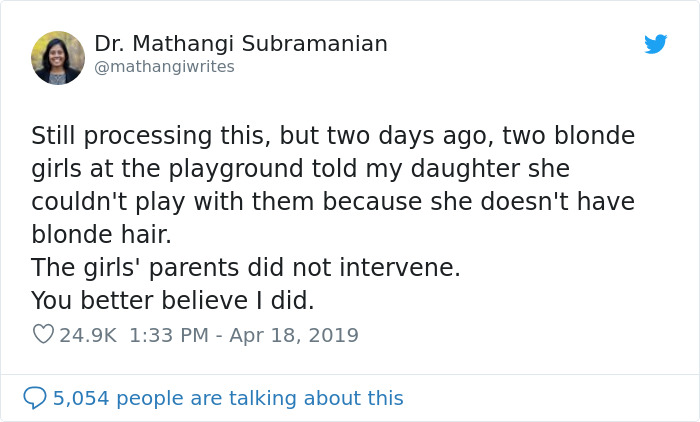
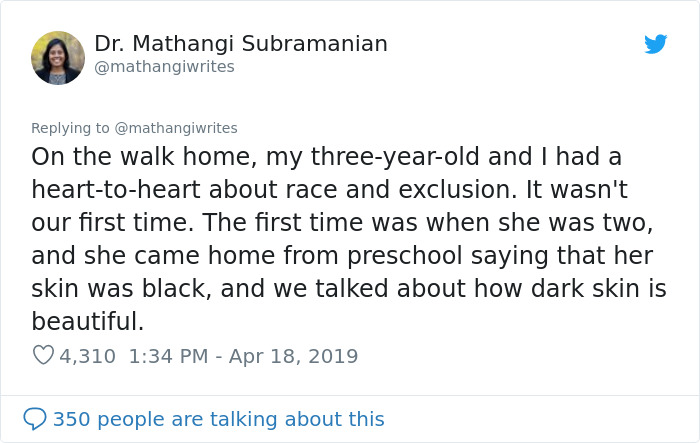
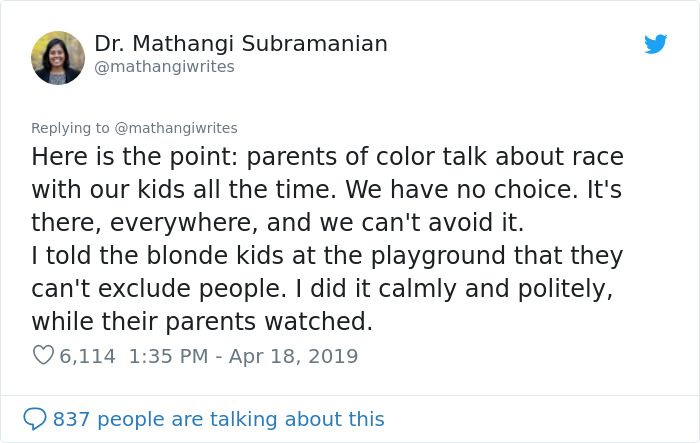
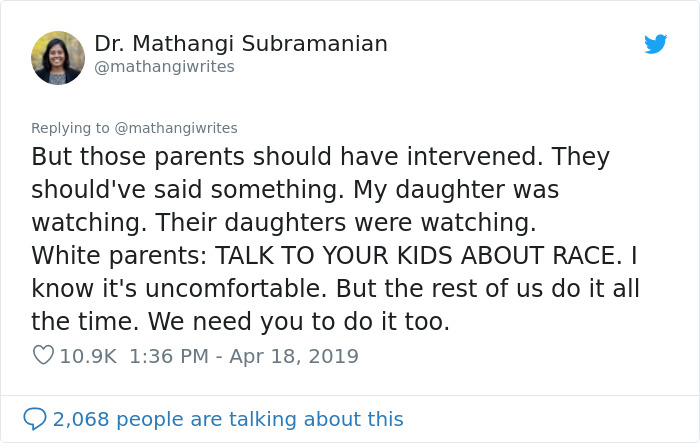
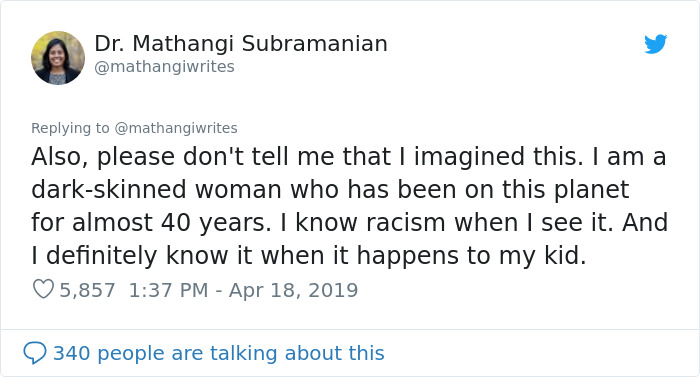
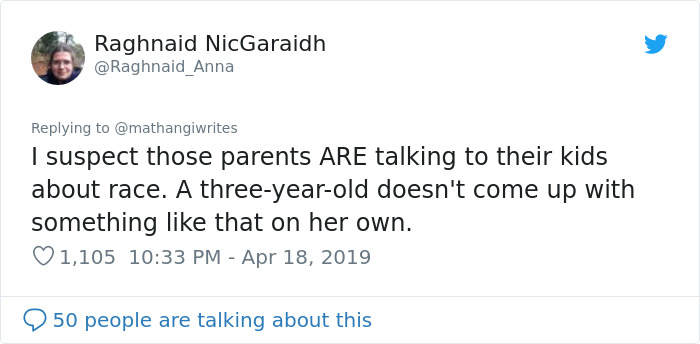
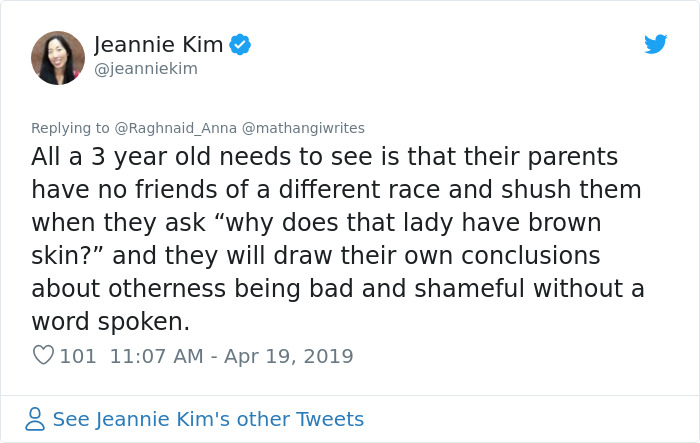
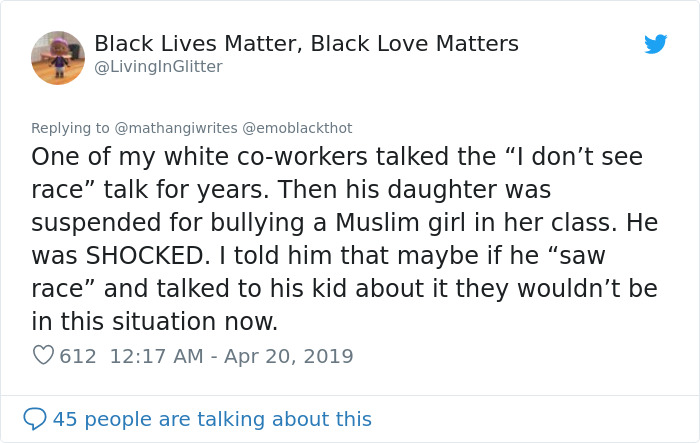
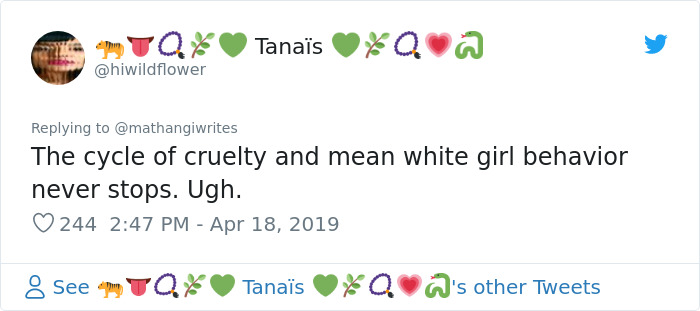
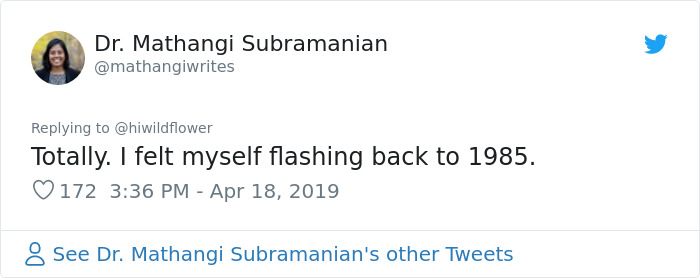
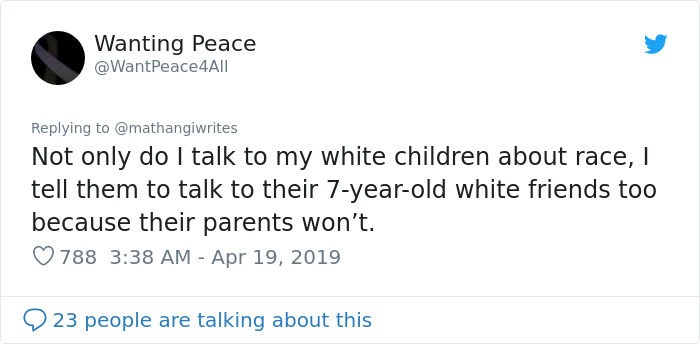
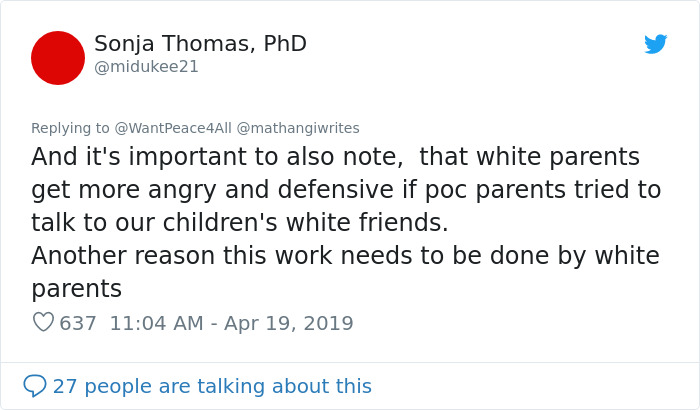
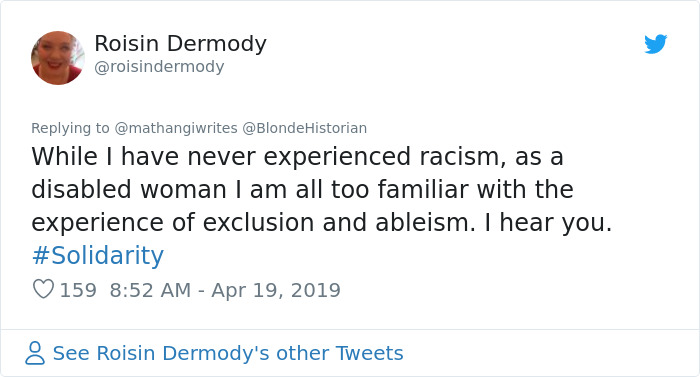
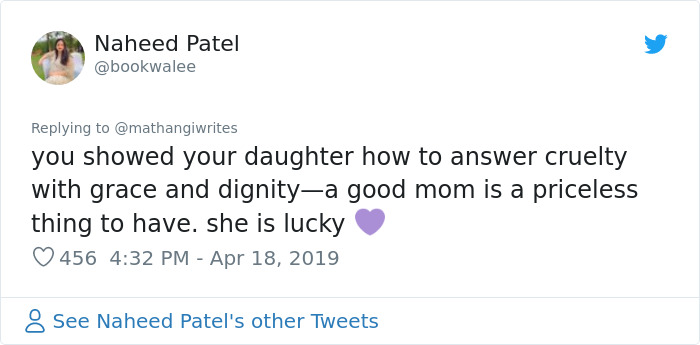
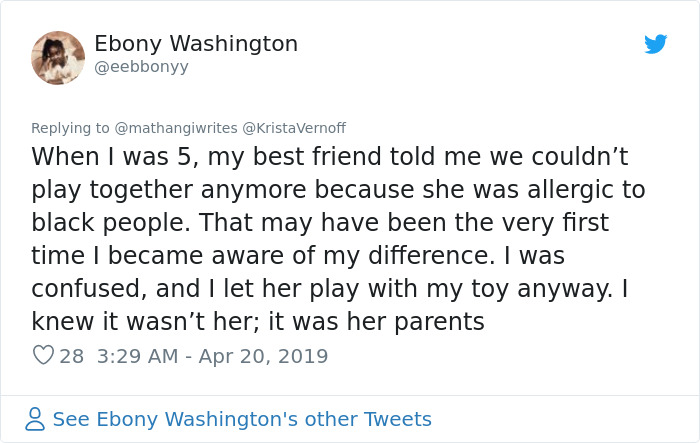
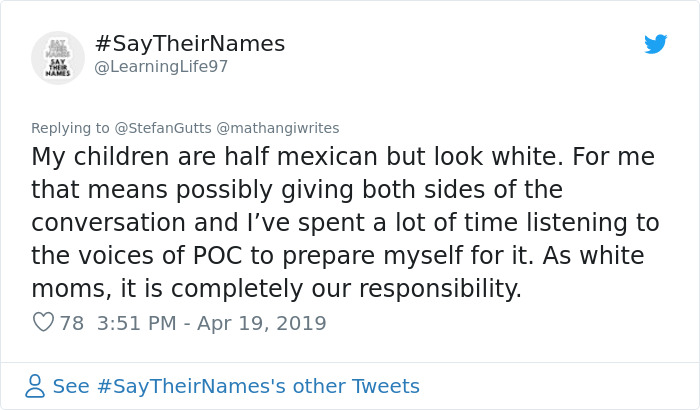
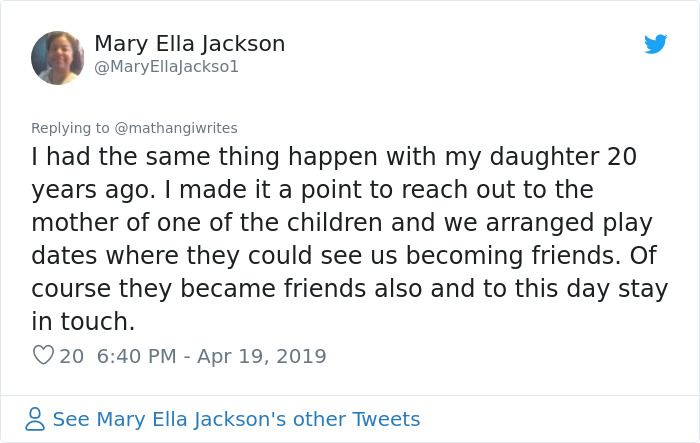
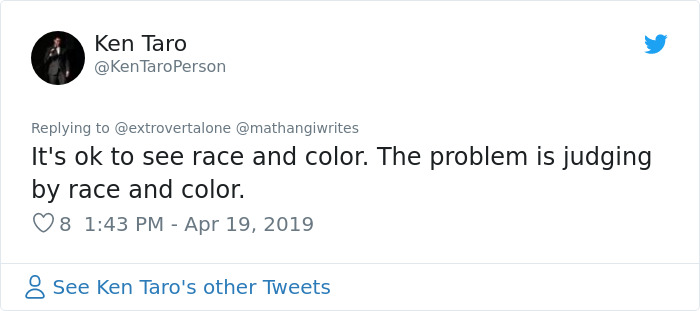
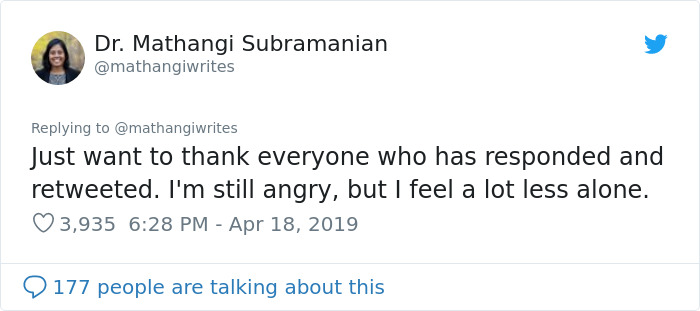
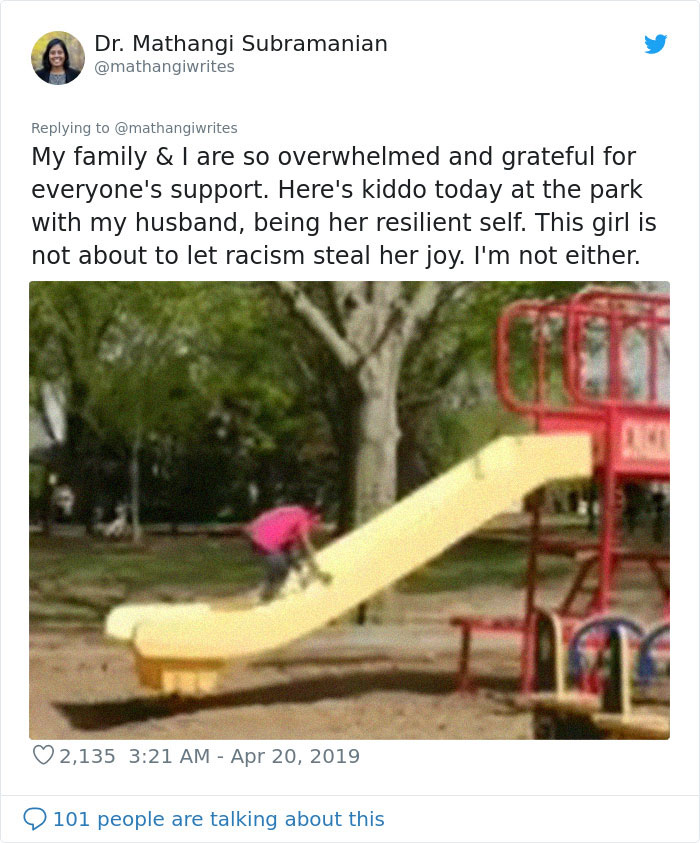




151
106